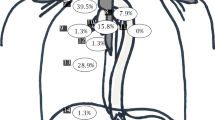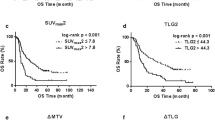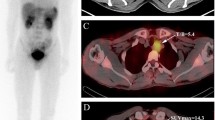Abstract
Purpose
To assess a novel radiotracer aluminum [18F]fluoride-1,4,7-triazacyclononane-triacetic acid-pegylated dimeric RGD ([18F]ALF-NOTA-PRGD2, denoted as [18F]Alfatide) for positron emission tomography (PET)/X-ray computed tomography (CT) and explore the relationships between clinicopathological characteristics and maximum standard uptake values in primary (SUVP) and metastatic lymph nodes (SUVLN) of patients with esophageal squamous cell carcinoma (ESCC), as verified by pathologic examination and compared with those obtained with 2-deoxy-2-[18F]fluoro-D-glucose ([18F]DG) PET.
Procedures
We prospectively enrolled patients with newly diagnosed ESCC who agreed to undergo [18F]Alfatide PET/CT or [18F]FDG PET/CT scans before surgery at Shandong Cancer Hospital from May 2011 to July 2017. SUVs and the pathological tumor-node-metastasis (pTNM) stages of primary tumors and metastatic lymph nodes (LNs) were measured and confirmed pathologically. Immunohistochemical (IHC) staining for integrin αvβ3 was performed on tumor samples (both primary tumors and metastatic LNs) collected from nine patients.
Results
Of 61 patients who underwent PET/CT scans, 46 then underwent curative surgery and were included in our analysis (n = 21 for [18F]Alfatide PET/CT and n = 25 for [18F]FDG PET/CT). No significant differences in the SUVP on [18F]Alfatide PET/CT or [18F]FDG PET/CT were observed among the cohorts according to gender, pathological stage, T stage, status of LNs, and differentiation (all P > 0.05). The SUVLN differed significantly between the pathological stages and status of LNs both on [18F]Alfatide PET/CT (P = 0.03, 0.003) and [18F]FDG PET/CT (P = 0.001. < 0.001), but not according to gender (P = 0.128, 0.129), T stage (P = 0.791, 0.727), or tumor differentiation (P = 0.049, 0.053). Significant positive correlations were observed between the SUVLN on [18F]Alfatide PET/CT and [18F]FDG PET/CT, and pathological stage (r = 0.52, P = 0.016; r = 0.503, P = 0.01), LN status (r = 0.73, P < 0.001; r = 0.649, P < 0.001), and differentiation (r = 0.509, P < 0.019; r = 0.459, P = 0.021) were observed. No significant differences were found between the relationships of SUVP with SUVLN, length, age, gender, pathological stage, T stage, status of LN, or differentiation, or of SUVLN with length, age, gender, or T stage both on [18F]Alfatide PET/CT and [18F]FDG PET/CT (all P > 0.05). The quantitated expression levels of αvβ3 in primary tumors and metastatic LNs were 1.67 ± 1.12 and 3.42 ± 2.93, respectively (P = 0.031).
Conclusions
Our results suggest that SUVLN is influenced by pathological stage, LN status, and differentiation. SUVLN may therefore serve as a new parameter for risk stratification of with ESCC patients. Moreover, [18F]Alfatide PET can provide complementary molecular information about ESCC metastasis.


Similar content being viewed by others
References
Czernin J, Phelps ME (2002) Positron emission tomography scanning: current and future applications. Annu Rev Med 53:89–112
Phay JE, Hussain HB, Moley JF (2000) Strategy for identification of novel glucose transporter family members by using internet-based genomic databases. Surgery 128:946–951
Flamen P, Lerut A, Van Cutsem E et al (2000) Utility of positron emission tomography for the staging of patients with potentially operable esophageal carcinoma. J Clin Oncol 18:3202–3210
Heeren PA, Jager PL, Bongaerts F, van Dullemen H, Sluiter W, Plukker JT (2004) Detection of distant metastases in esophageal cancer with 18F-FDG PET. J Nucl Med 45:980–987
Strauss LG (1996) Fluorine-18 deoxyglucose and false-positive results: a major problem in the diagnostics of oncological patients. Eur J Nucl Med 23:1409–1415
van Westreenen HL, Heeren PA, Jager PL et al (2003) Pitfalls of positive findings in staging esophageal cancer with F-18-fluorodeoxyglucose positron emission tomography. Ann Surg Oncol 10:1100–1105
Ishimori T, Saga T, Mamede M, Kobayashi H, Higashi T, Nakamoto Y, Sato N, Konishi J (2002) Increased (18)F-FDG uptake in a model of inflammation: concanavalin A-mediated lymphocyte activation. J Nucl Med 43:658–663
Kubota R, Yamada S, Kubota K, Ishiwata K, Tamahashi N, Ido T (1992) Intratumoral distribution of fluorine-18-fluorodeoxyglucose in vivo: high accumulation in macrophages and granulation tissues studied by microautoradiography. J Nucl Med 33:1972–1980
Hood JD, Cheresh DA (2002) Role of integrins in cell invasion and migration. Nat Rev Cancer 2:91–100
Wu C, Yue X, Lang L, Kiesewetter DO, Li F, Zhu Z, Niu G, Chen X (2014) Longitudinal PET imaging of muscular inflammation using 18F-DPA-714 and 18F-Alfatide II and differentiation with tumors. Theranostics 4:546–555
Gao S, Wu H, Li W, Zhao S, Teng X, Lu H, Hu X, Wang S, Yu J, Yuan S (2015) A pilot study imaging integrin αvβ3 with RGD PET/CT in suspected lung cancer patients. Eur J Nucl Med Mol Imaging 42:2029–2037
Luan X, Huang Y, Gao S, Sun X, Wang S, Ma L, Teng X, Lu H, Yu J, Yuan S (2016) 18 F-alfatide PET/CT may predict short-term outcome of concurrent chemoradiotherapy in patients with advanced non-small cell lung cancer. Eur J Nucl Med Mol Imaging 43:2336–2342
Zhang H, Liu N, Gao S, Hu X, Zhao W, Tao R, Chen Z, Zheng J, Sun X, Xu L, Li W, Yu J, Yuan S (2016) Can an 18F-ALF-NOTA-PRGD2 PET/CT scan predict treatment sensitivity to concurrent chemoradiotherapy in patients with newly diagnosed glioblastoma. J Nucl Med 57:524–529
Wan W, Guo N, Pan D, Yu C, Weng Y, Luo S, Ding H, Xu Y, Wang L, Lang L, Xie Q, Yang M, Chen X (2013) First experience of 18F-alfatide in lung cancer patients using a new lyophilized kit for rapid radiofluorination. J Nucl Med 54:691–698
Beer AJ, Haubner R, Sarbia M, Goebel M, Luderschmidt S, Grosu AL, Schnell O, Niemeyer M, Kessler H, Wester HJ, Weber WA, Schwaiger M (2006) Positron emission tomography using [18F]Galacto-RGD identifies the level of integrin alpha(v)beta3 expression in man. Clin Cancer Res 12:3942–3949
Chen X, Sievers E, Hou Y, Park R, Tohme M, Bart R, Bremner R, Bading JR, Conti PS (2005) Integrin alpha v beta 3-targeted imaging of lung cancer. Neoplasia 7:271–279
Thurau K, Palmes D, Franzius C, Minin E, Senninger N, Juergens KU, Bruewer M (2011) Impact of PET-CT on primary staging and response control on multimodal treatment of esophageal cancer. World J Surg 35:608–616
Suzuki A, Xiao L, Hayashi Y, Macapinlac HA, Welsh J, Lin SH, Lee JH, Bhutani MS, Maru DM, Hofstetter WL, Swisher SG, Ajani JA (2011) Prognostic significance of baseline positron emission tomography and importance of clinical complete response in patients with esophageal or gastroesophageal junction cancer treated with definitive chemoradiotherapy. Cancer 117:4823–4833
Cerfolio RJ, Bryant AS (2006) Maximum standardized uptake values on positron emission tomography of esophageal cancer predicts stage, tumor biology, and survival. Ann Thorac Surg 82:391–394; discussion 394-395
Rizk N, Downey RJ, Akhurst T, Gonen M, Bains MS, Larson S, Rusch V (2006) Preoperative 18F-fluorodeoxyglucose positron emission tomography standardized uptake values predict survival after esophageal adenocarcinoma resection. Ann Thorac Surg 81:1076–1081
Vesselle H, Schmidt RA, Pugsley JM, Li M, Kohlmyer SG, Vallires E, Wood DE (2000) Lung cancer proliferation correlates with [F-18]fluorodeoxyglucose uptake by positron emission tomography. Clin Cancer Res 6:3837–3844
Feng R, Li MH, Kong L, Shi F, Yang GR, Yu JM (2009) Correlation between PET-CT 18FDG uptake in primary lesions and clinicopathological parameters in esophageal carcinoma patients. Zhonghua Zhong Liu Za Zhi 31:452–454
Mu DB, Wang SP, Yang WF et al (2007) Correlation between FDG PET/CT and the expression of glutl and ki-67 antigen in esophageal cancer. Zhonghua Zhong Liu Za Zhi 29:30–33
Wu C, Yue X, Lang L, Kiesewetter DO, Li F, Zhu Z, Niu G, Chen X (2014) Longitudinal PET imaging of muscular inflammation using 18F-DPA-714 and 18F-Alfatide II and differentiation with tumors. Theranostics 4:546–555
Hynes RO (2002) A reevaluation of integrins as regulators of angiogenesis. Nat Med 8:918–921
Sun M, Li B, Fu Z et al (2013) Relationship between 18F-fluorodeoxyglucose uptake in primary lesions and clinicopathological characteristics of esophageal squamous cell carcinoma patients. Exp Ther Med 5:170–174
Liu H, Lu L, Zhu Q, Hao YT, Mo YX, Liu M, Hu YH, Cui NJ, Rong TH (2011) Cervical nodal metastases of unresectable thoracic esophageal squamous cell carcinoma: characteristics of long-term survivors after concurrent chemoradiotherapy. Radiother Oncol 99:181–186
Eloubeidi MA, Desmond R, Arguedas MR, Reed CE, Wilcox CM (2002) Prognostic factors for the survival of patients with esophageal carcinoma in the U.S.: the importance of tumor length and lymph node status. Cancer 95:1434–1443
Roedl JB, Sahani DV, Colen RR, Fischman AJ, Mueller PR, Blake MA (2008) Tumour length measured on PET-CT predicts the most appropriate stage-dependent therapeutic approach in oesophageal cancer. Eur Radiol 18:2833–2840
Acknowledgments
The authors extend their gratitude to Professor Yongsheng Gao (Department of Pathology, Shandong Cancer Hospital and Institute) for his help with IHC analysis and Jianbo Zhang (Department of Pathology, Shandong Cancer Hospital and Institute) for his help with the IHC examination.
Funding
This study was partially funded by the Special Fund for Scientific Research in the Public Interest (201402011), the National Key Research and Development Plan (2016YFC0904700), the Natural Science Foundation of China (NSFC81172133, NSFC81372413), the Shandong Key Research and Development Plan (2017CXGC1209 and 2017GSF18164), and the Outstanding Youth Natural Science Foundation of Shandong Province (JQ201423).
Author information
Authors and Affiliations
Corresponding author
Ethics declarations
This study was approved by the ethics committee of Shandong Cancer Hospital, and each patient provided written informed consent prior to the study.
Conflict of Interest
The authors declare that they have no conflict of interest.
Rights and permissions
About this article
Cite this article
Dong, Y., Wei, Y., Chen, G. et al. Relationship Between Clinicopathological Characteristics and PET/CT Uptake in Esophageal Squamous Cell Carcinoma: [18F]Alfatide versus [18F]FDG. Mol Imaging Biol 21, 175–182 (2019). https://doi.org/10.1007/s11307-018-1216-9
Published:
Issue Date:
DOI: https://doi.org/10.1007/s11307-018-1216-9




